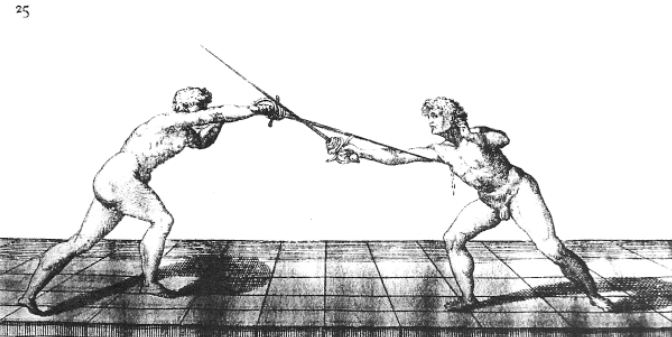First of (hopefully) a series, to revenge myself ironically on Letia’s ill-conceived term “plateify”. (Don’t ask.) I’ll be taking a plate each week or so and drilling it, then presenting my findings here.
In this episode, I attempt to ameliorate my abysmal oblique footwork. Fabris seems fairly consistent in advocating an offline step to the outside when attacking or lunging to the outside, and I need to work on my outside game anyway, so it seems a good place to start.
The play itself is quick, but there’s a fair amount of detail.
Agente and Patiente start in terza to the outside, at long measure and parity.
Agente
Push the right foot forward
Forcefully press against Patiente’s sword to push it out of line
Patiente
Resist pressure, turn to prima
Push right foot forward and offline to the left. Strike (plate)
Bring left foot behind the right, and recover to guard
Drilling Correctly:
– Properly performed, Agente will cause his own sword to be found; once Patiente turns to prima, Agente’s pressure against the blade will cause his debole to slide to Patiente’s forte. Patiente must drop his point to achieve this angle (see illustration).
– As is often the case, the drill must be done with some speed and intent to work properly. Train up the footwork first (as the offline step is a bit foreign to most fencers) so you can do it without thinking and focus on performing the bladework in the correct tempo.
– The drill can also be performed with the fencers starting in seconda, with no changes.
– The offline step strengthens Patiente’s angle and is especially important for landing a killing shot when both fencers begin in seconda.
– If Patiente is wounding the shoulder or under the arm, you’re doing it wrong (probably failing to drop the tip when Patiente turns to prima). The strike should come over the arm and land somewhere in Agente’s chest, no higher than his neck.
– Note Patiente’s posture in the illustration–specifically, he is very upright. Falling into a too-low lunge can foul the angle created by turning to prima.
– As in all things, hand before foot. Pushing the foot forward before turning the hand usually causes both blades to become locked in each others’ quillions. It’s ugly. Don’t do it.
– This plate beautifully illustrates the maxim “the blade is stronger on the side to which it points”.
Expanding the Drill:
– Once you are comfortable with the movement, have Agente apply less and less pressure, for less and less time to train an automatic, instantaneous reaction triggered by the slightest pressure on your blade.
– Turn the drill into a pressure/no-pressure drill to the outside–but instead of disengaging or yielding around Agente’s pressure, turn to an advantageous angle (prima). Do the same to the inside.
– Performed in the proper tempo, Patiente’s action is a counter-find. Have Agente find Patiente’s sword with his initial step in addition to applying pressure; Patiente must counter in contratempo, or his blade will be taken off line immediately.
Notes:
– Fabris mentions very little about the footwork here; his only note is that Patiente is taking the offline step. Due to the illustration of Agente’s front foot and leg, and due to the fact that no intelligent fencer will press on his opponent’s blade for any significant length of time within measure, I inferred that Agente’s pressure is understood to come in the course of an earnest attack to the outside. Likewise, the footwork behind Patiente’s recovery is not mentioned; but the raised left foot in the illustration and the principles of Italian fencing suggest the interpretation I have given here.
Questions:
– Patiente’s offline step necessarily brings his right leg and hip to a different angle (pointing off to the left rather than straight at his opponent); does the right foot stay in line with the leg and hip, or does it stay straight and not change its angle? The former feels a lot more stable and seems more in line with Italian principles of good body mechanics; but the latter seems to give a little more reach and seems to fall closer to the plate’s illustration.
– Is it possible for Patiente to pass with the back foot rather than stepping with the front foot? When is one better than the other, and why?
– Fabris uses “pushes forward” to describe Patiente’s footwork here. Elsewhere this verbiage seems to describe a lunge. In drilling this plate, however, a lunge did not seem to work very well, and I’m at a loss for a good reason why. It may have been due to the height difference between the fencers … due to the importance of the angle formed by turning to prima, I’m not sure the play works if Patiente’s forte is not higher than Agente’s.
– Looking at the details of Patiente’s footwork, does the toe of the right foot leave the ground first, as for an advance or a lunge? Does the heel leave first? Or does the whole foot move as one? The “pillar and buttress” model seems to cause the weight to naturally shift forward when the toe leaves first, which is great for a lunge or a pass … but here, Patiente is not looking to move to the side, not forward.

Pingback: Dante di Pietro
Pingback: Ruairc
Pingback: Dante di Pietro
Pingback: Ruairc